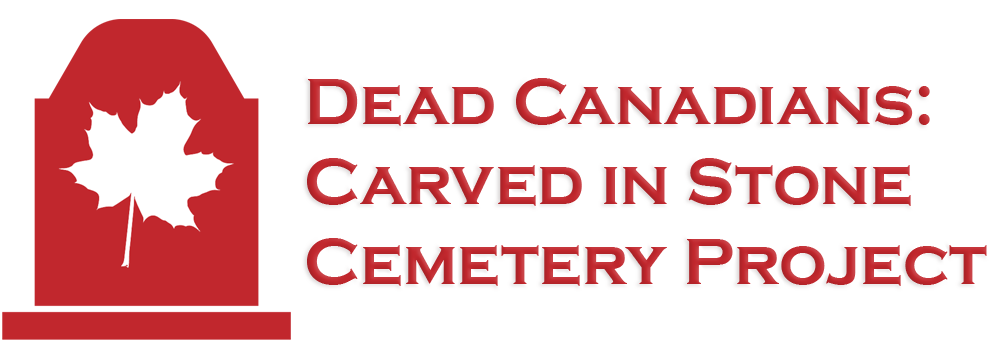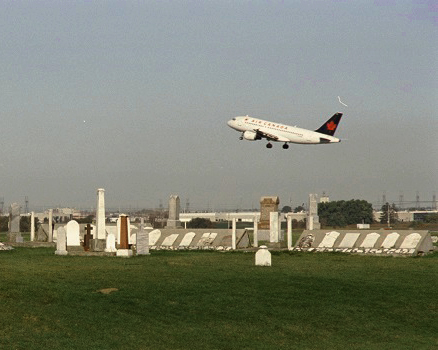Elmbank Cemetery, the second cemetery that was “in the way” of the development of Malton Airport (now Toronto’s Pearson International Airport), was handled differently than the cemetery for the nearby Bethany United Church.
The community of Elmbank was the first hamlet west of Sixth Line (Airport Road) on Britannia Road. It was named after the home of John Grubb in nearby St. Andrew (now Thistletown) in north Etobicoke. In Ron Brown’s book “Toronto’s Lost Villages” he notes the hamlet had a store, post office, blacksmith shop and a schoolhouse. To the south was the Wesleyan Methodist Church (later Bethany United) and to the north, a Catholic Church. Some other sources indicate that Elmbank was also home to a carriage maker and a cheese factory.
The Catholic graveyard, known as 5th Line Mission Cemetery, the Gore Cemetery and Elmbank Cemetery over its history, was opened in 1833 for the early Catholic settlers of rural Malton. It closed in 1939. When Malton airport was developed the site was initially left alone but in the 1960s jet aircraft began requiring longer runways and the former community of Elmbank was expropriated. The trees and the foundations of the main intersection were left undisturbed, laying in the shadow of the airport’s control tower. And a little ways north, right by the runway, lay the small cemetery. For many years, travellers could often catch a glimpse of cemetery when taking off or landing – I know I did!
Between late August 2000 and October 2001, Elmbank Cemetery was moved to a back section of Assumption Cemetery in Mississauga. According to the archdiocese of Toronto: “A number of organizations came together to complete the project, which included an extensive archaeological investigation, genealogical research, gravestone restoration, re-interment, and a memorial to the deceased. Elmbank Cemetery is the largest historic burial ground in Ontario ever to be relocated.” The surviving stones were relaid to resemble a 19th century Catholic cemetery in Ontario. It also contains a display containing gravestone pieces that could not be reassembled and a monument with the names of an estimated 60% of those buried there. Assumption Cemetery is located on Tomken Road, south of Derry Road. The new cemetery site was given a mass and blessing on Saturday, July 10, 2004.
When ASI (Archaeological Services Inc.) worked on the excavation of the site they found the stone foundation of the 1885 red brick church which had been demolished in 1930; they also found some remnants of stained glass and ceramics. At the time of the move from Pearson, there were 23 standing markers which had originally been intended to delineate plots. Most had been moved from their original locations over time including in 1954 after Hurricane Hazel had destroyed part of the cemetery. Many stone monuments, and one iron monument, had been gathered together onto a concrete slab. Most of the flat tombstones had been gathered together into six double-sided concrete cairns, with smaller fragments set in the base of the cairns.
In total, ASI removed the remains of 622 individuals. Found with the bodies were many personal items, such as rosaries, rings, medallions, coins, bottles, pipes and crucifixes. Also recovered were glass eyes and dentures. All personal items, as well as coffin hardware (name plaques, handles, decorative screws), were reinterred with the original owners at Assumption Cemetery. In a breakdown of the identified remains: 139 were elderly, 251 were adults (aged 18 to 49), 18 were adolescent, 107 were children, 56 were infants <year, 25 were newborns <month, and 6 were fetal.
According to the Archdiocese of Toronto, the present Elmbank Cemetery within Assumption Cemetery, is in four sections:
1) “The first section is a restoration of Elmbank Cemetery as a 19th century Canadian Catholic cemetery, thanks to the monument (tombstone) restoration program. The monuments found at the airport site that were related to identified human remains were accordingly erected at the appropriate burial sites.
2) The second section contains the human remains that were identified but for which no monument exists. For each of these burials, contemporary burial markers were suggested.
3) The third section includes all unidentified human remains and is located east of the main memorial monument.
4) The fourth section is the exhibition of monuments found at the airport site not matching identified burials.”




Leave a Reply